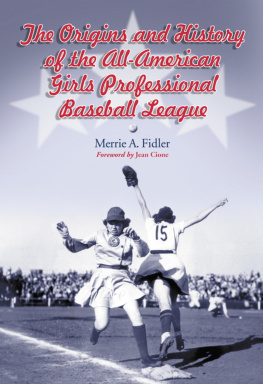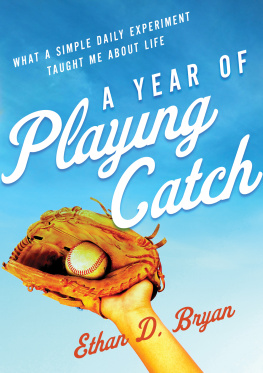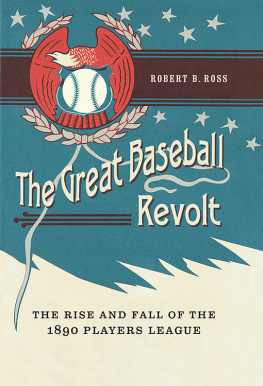
The All-American Girls After the AAGPBL
How Playing Pro Ball Shaped Their Lives
Kat D. Williams

McFarland & Company, Inc., Publishers
Jefferson, North Carolina
LIBRARY OF CONGRESS CATALOGUING DATA ARE AVAILABLE
BRITISH LIBRARY CATALOGUING DATA ARE AVAILABLE
e-ISBN: 978-1-4766-2695-6
2017 Kat D. Williams. All rights reserved
No part of this book may be reproduced or transmitted in any form or by any means, electronic or mechanical, including photocopying or recording, or by any information storage and retrieval system, without permission in writing from the publisher.
On the cover Maybelle Blair at the 2015 Baseball for All National Tournament in Orlando, Florida (author collection)
McFarland & Company, Inc., Publishers
Box 611, Jefferson, North Carolina 28640
www.mcfarlandpub.com
For Greta Rensenbrink,
without whom this book would not exist.
With you, all things are possible.
Acknowledgments
From its inception, this project benefited from the help and support of countless people, especially my mom and dad, TJ and Sara Williams. They taught me to love baseball and to appreciate and respect the significance of the game. It was my early connection to the game that saved me as a child and motivated me as an adult. To my sister and lifelong champion, Kim Williams, who made me laugh when humor was the only way forward and endured countless baseball events on my behalf, thank you. To my brother-in-law, Michael Hammond, whose zest for life inspired me and provided the extra motivation needed to finish this book, hoist!
To my Rensenbrink family, who provided summer retreats and unconditional love, support, and lobster, thank you. You will never know how much easier this task has been having the Rensenbrink force on my side.
To the dogs in my lifeLittle, Sea and Zelda RoseI literally could not have done this without you.
One very important lesson I learned during the time spent on this book is that families are often made, not inherited. By 2005, I had met Maybelle Blair, Terry Donahue, Pat Henschel, Jane Moffet, Isabel Alvarez, Shirley Burkovich, and Kristen Huff. My life has been richer, happier, and more fulfilled because of them. Each and every one contributed to this book in innumerable ways. They are, and will forever be, family.
My extended baseball family, the team that makes up the International Womens Baseball CenterPerry Barber, Donna Cohen, Cami Kidder, and Debbie Piersonnever wavers in its support of womens baseball, and especially my role in it. Thank you for the example you set.
The faculty and staff of Marshall Universitys history department supported me and remained steadfast in their belief that I could write this book. From my first days at Marshall, Montserrat Miller took me under her wing and, through her own example, helped me believe, too. A special thanks to my colleagues, Bob Deal, Dan Holbrook, Donna Spindel, and Chris White, for their friendship, understanding, and encouragement.
Over the years I have had a number of bright, talented students. One such student, Kaitlyn Haines, worked as a research assistant on this book. Thank you.
A number of the research trips conducted on behalf of this project were made possible through the support of Marshall Universitys Quinlan and Inco programs. The project was also supported by two sabbaticals from Marshall University and its College of Liberal Arts.
Tim Wiles, director of research at the National Baseball Hall of Fame in 2002, first introduced me to the women of the All-American Girls Professional Baseball League (AAGPBL) and set this whole project in motion. Thank you.
To the women of the All-American Girls Professional Baseball League, thank you. Your strength and courage inspire me every day. It is my hope that this book does justice to your story and the lives you created after the league.
Preface
This book explores the role of sports in creating identityin particular, the ways in which access to baseball affected the lives of the women who played in the All-American Girls Professional Baseball League (AAGPBL).
I began this project after a group of students challenged me to show them real-life examples of why and how sports were important to women. The AAGPBL players provide the lens through which I explore the themes of financial benefit, travel, exposure to diversity, patriotism, and, finally, the womens legacy.
Their salaries, high for women of the time, gave every player an opportunity to make more money than they might have obtained in what were then socially acceptable (and usually lower-paying) jobs. The fact that these women earned that money by playing professional baseball made the experience even better. Travel and the chance to encounter new people were important byproducts of life in the league. Many of the players were from small towns, and the opportunity to see and experience different places and cultures was invaluable, changing their lives more profoundly than any other benefit of playing in the league. Additionally, for some of the players and league personnel, patriotism and military service were connected to their time in the AAGPBL. Players self-described place in American history and their role in what some have called a revolution in womens sports is still another focus of this book. In this narrative, the players experiences and stories come together to paint a picture of the leagues impact on these women.
Introduction
A woman may take part in the grandstand, with applause for the brilliant play, with a waving kerchief to the hero. But neither our wives, our sisters, our daughters, nor our sweethearts, may play Base Ball on the field. Base Ball is too strenuous for womankind.
Dorothy Seymour Mills and Harold Seymour
As a woman who played softball in the years before the passage of Title IX (which requires schools receiving federal money to provide girls with equal opportunities in all areas, including sports), I am very protective of the legislation and sensitive to any measures that would weaken it. A few years ago, when I read about yet another attempt to strip Title IX of its power, I took the opportunity to discuss the issue in my womens history class. I asked my students whether they thought Title IX was still relevant. Some of the young women, many of them athletes, argued that womens sports are so much a part of modern society that women dont need this kind of protection anymore. It is easy to find examples of players who earn a good living and have made names for themselves in the world of sports, they said. These students pointed to golf star Michelle Wie and tennis greats like the Williams sisters to prove that female athletes have gained full access to the professional opportunities men have enjoyed for years. But others among my largely working-class students were not impressed by these examples. In their minds, those sports exude privilege, and the women who play them have lives my students could not relate to. Poor people like us dont belong to the country club, they countered. Someone pointed out that we now have professional womens basketball with the WNBA (Womens National Basketball Association). Basketball is played in the streets and schoolyards, not in a country club. Thats only one sport, I responded, and the WNBA is struggling to reach fans.
Another group of studentsthe non-sports-minded members of the classwere more dismissive. They argued that we have other, more important things to worry about, like equal opportunity in employment, housing, and education. Its only sports, they said. I protested, explaining that equality is important regardless of the aspect of life in question. Sports can also provide very tangible advantages, such as a good salary and professional opportunities. Plus, I argued, sports give young girls other benefits, like the chance to learn teamwork, experience victory, and practice good sportsmanship. Most important, I said, sports can give girls and women the confidence and independence to succeed in all aspects of lifea financial, emotional, and physical foundation on which the rest of their lives can flourish.
Next page







